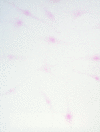Characterisation of fibroblast-like cells in pannus lesions of patients with rheumatoid arthritis sharing properties of fibroblasts and chondrocytes
- PMID: 9166000
- PMCID: PMC1752353
- DOI: 10.1136/ard.56.4.262
Characterisation of fibroblast-like cells in pannus lesions of patients with rheumatoid arthritis sharing properties of fibroblasts and chondrocytes
Abstract
Objective: To better understand the characteristics of synoviocytes located in the rheumatoid arthritis (RA) pannus.
Methods: One cell line, termed PSC, was cloned from RA pannus lesions. Phenotypic analysis was done by contrast microscopy, indirect immunostaining, and safranin O staining. Transcription of several protooncogenes and matrix degrading enzymes was evaluated. The expression of mRNA for collagen II was detected by in situ hybridisation. The ability of anchorage independent growth was assessed by soft agarose culture.
Results: PSCs showed a high transcription of protooncogenes c-fos, c-myc and c-jun. They also expressed mRNA for matrix degrading enzymes, such as collagenase, cathepsin B, and cathepsin L. Anchorage independent growth assay demonstrated that PSCs formed colonies in soft agar culture. Phenotypic analysis showed that this fibroblast-like PSC was stained intensely with anti-vimentin and anti-fibroblast antibody. In situ reverse transcriptase assay showed that the cell line expressed type II collagen mRNA.
Conclusion: Alternative fibroblast-like cells were identified in the pannus lesion of RA sharing properties of fibroblasts and chondrocytes. These findings suggest that this fibroblast-like cell derived from pannus lesions may contribute to the destruction of the cartilage in RA.
Figures





References
Publication types
MeSH terms
Substances
Associated data
- Actions
- Actions
- Actions
- Actions
- Actions
- Actions
- Actions
LinkOut - more resources
Full Text Sources
Other Literature Sources
Medical
Molecular Biology Databases
Miscellaneous

